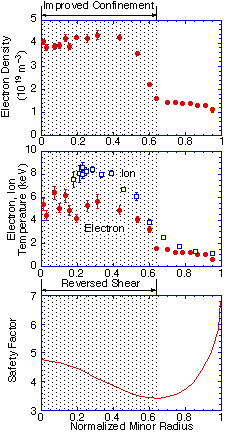Confinement Improvement with Negative Magnetic Shear
Recent JT-60U experiments have demonstrated the drastic improvement in particle and thermal confinement with a negative magnetic shear configuration stable as theoretically predicted by Dr. T. Ozeki et al. [1]. Significant reduction of electron thermal transport within the negative shear region extended over a half of the plasma minor radius is highlighted here, though it has not been observed in other similar experiments on TFTR and DIII-D.
- Internal Transport Barrier
The negative shear is produced in the plasma with a hollow current profile, within which significant reduction of electron thermal transport as well as of ion thermal and particle transport was observed. The magnetic shear goes to zero as the safety factor becomes minimum, at which remarkable discontinuities in electron and ion temperatures and density profiles exhibit an internal transport barrier in the plasma interior. - Increasing Promise for SSTR
Since a stable and well-confined plasma was demonstrated consistent with a negative magnetic shear configuration essential for a bootstrap current profile, the development of advanced tokamak reactors such as the Steady State Tokamak Reactor (SSTR) has become much more promising where both highly enhanced performance and high bootstrap current fraction are required.[1] T. Ozeki et al., 14th IAEA Conf. Proc., Wzburg (1992) vol. 2, p.187.

